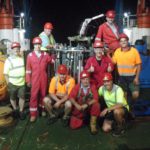…that is if you forget that they are gas-guzzling uber machines spewing carbon dioxide.

the first indirect effect, whereby an increase in aerosols causes an increase in droplet concentration and a decrease in droplet size for fixed liquid water content (Twomey, 1974), and the second indirect effect, whereby the reduction in cloud droplet size affects the precipitation efficiency, tending to increase the liquid water content, the cloud lifetime (Albrecht, 1989), and the cloud thickness (Pincus and Baker, 1994).
These ship-caused clouds can reflect light. Locally this can be up to 100 watts per meter squared, for comparison the flux at the top of the atmosphere is around 340 watts per meter squared. Obviously, this is fairly large effect locally and potentially problematic given the thousands of ships that clog the ocean’s shipping lanes (below). What has not been quantified until now is how these clouds affect the global albedo (the extent to which the earth reflects light, defined as the ratio of reflected to incident electromagnetic radiation). Schreier et al. using satellite imagery, algorithms to extract ship clouds from the images, and modeling, estimate the impact on global albedo. Overall their analysis show that the effects are relatively small compared to the total anthropogenic effect (0.4 to 0.6mW/m2 versus 0.6 to 2.4 W/m2).







Okay, let’s start from the perspective that a) I haven’t looked at global albedo effects vs. global warming and b) I don’t have access to the full article. In practice, as an applied researcher, I’d have still (somewhere in the Discussion section, probably) have talked about the relationship between albedo and overall CO2, etc. effects of increased hydrocarbon burning/emissions — to do otherwise would be frankly shirking the application of such work.
So, albedo might be good, but CO2 and CO emissions off those ships probably offset any of those positives. All positive anthropogenic effects of buying cheap wooden frogs and tequila/rum aside, big ships still equal bad things ecologically. My challenge to the authors of the study is to prove otherwise.
Just my two-cents’ worth…
Dave,
Great point. The fossil fuels these ships guzzle and the emissions are still in play and may represent a considerable source to ecological damage. Have edited the post to say this.
Wasn’t a similar point made after 9/11 with jet exhaust influencing weather or storm formation patterns?
That sounds like a pretty significant effect to me .5W/M**2, versus a bit more than 1W/M**2 from CO2. If these numbers are right this effect could be masking about a third of the CO2 forcing!
Jeb: The jet contrails occurring at high altitudes tend to have a warming effect (they shield more long wave radiation going to space than they reflect sunlight). Low clouds don’t shield much long-wave, as their temperature is not much different from the surface temperature. So from a cooling perspective low clouds good, high clouds bad.
I have heard geo-engineering proposals to exploit this effect to mitigate climate warming. Of course we hopefully don’t need to burn fossil fuels to create condensation nuclei. And the geographic distribution of the forcing is un-even. But perhaps it can be used to mitigate the zeroth order effect of global temperature increase.
Tom thats 0.5 mW (milliwats) versus 1W.